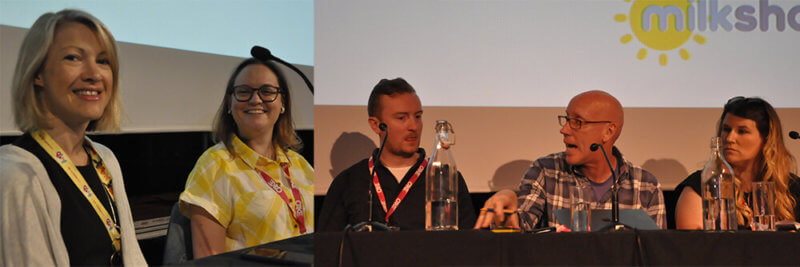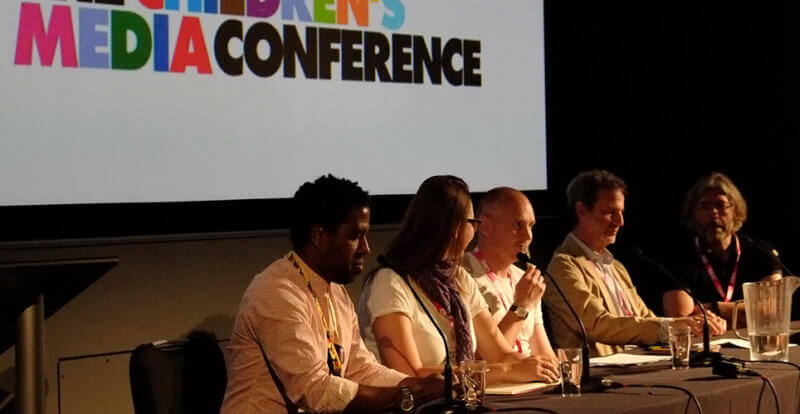CMC 2019: Pre-School Show Considerations, VR for Children, & Is There Too Much Content Out There?
Another Children’s Media Conference has been and gone, with the 2019 edition being bigger than ever before, and breaking a few records along the way. This year there were over 1,200 delegates present to take in the 60 sessions that were crammed into the 3 day conference.
Since 2016, it has been common for the dreaded ‘B’ word (shhhh…. Brexit) to dominate the conversation and some sessions; however, this year it was only muttered a few times. In contrast, there was a sense of optimism and positivity with regards to funding… Enter the two new funds on the block: The YAC Fund (The Young Audiences Content Fund, which launched in April this year), and the Animation Skills Fund, which we will be expanding upon in Skwigly in the coming days.
Aside from this good news, there were many 2019 highlights, including the International Exchange, SkillBuilder ‘Bible & Pitch’ Workshop, plus the two excellent keynotes with Nadiya Hussain and the Horrible Histories Movie team. Although we couldn’t possibly cover all of our favourite sessions from this year, luckily you can read the reports from every one of them on the CMC website – each report contains a detailed write up and some ‘takeaway’ pointers.
Instead, we have isolated a couple of sessions and distilled them down to some easily digestible bullet points, for anyone interested in augmented reality (AR) and virtual reality (VR) for children, or those looking at pitching their own pre-school show.
Pushing the Preschool Envelope

Panel: Jodie Morris (Acamar Films), Sarah Broad (Kelebek Media), Jon Benoy (Moonbug), Christopher Skala (Happy Alchemy), Lynsey O’Callaghan (Viacom)
This session was filled with both seasoned pre-school content creators, and novices alike, all hoping to gain some insights from the panel of industry figures who work in pre-school media. The presentation was framed around the ‘pillars of a pre-school show’; the areas surrounding an IP that should be considered as you develop your show:
Inclusion and diversity
- The most important ingredient for a successful show is well defined, relatable characters – don’t be ‘tokenistic’ and try and tick all the diversity boxes just to appear inclusive
- At the heart of all pre-school shows is one theme: family. Whoever it is made up from, everyone has a family
- If you want to build a global audience, you have to be diverse and inclusive… be brave!
Social
- It is difficult to reach the intended audience on social media, as pre-schoolers are not on these platforms at this age. Instead, aim for the parents. Sarah & Duck is an ideal example of a show that has connected with adults, mainly via its Facebook activity
- As social media is very noisy and busy, your timing is crucial. Don’t wait months after your show has aired – you need to ride the wave as it broadcasts and you need to have you social media strategy pre-planned.
Merchandise
- The old business model of having a ‘toy-etic’ show – where you would use a merchadise deal to fund production – is dead
- The ‘content monopolisers’ (Netflix, Amazon, etc.) have switched this. Now, the deal being offered is that a creator has to hand over all of the rights in order to get their show made. These content monopolisers are seeking more and more IP ownership, making it difficult for creators to hold on to their rights
- Audiences don’t care about the age of an IP – Friends is an ideal example of how an old brand can become a new brand
Platforms
- Pre-school audiences are now consuming more media on tablet devices
- Regarding your show, try to be everywhere that children are, although remember that content should be appropriate for the platform it’s going on
- Think about how your show can be re-purposed, whether that is on social media or a secondary platform
- Try and think how to engage with the audience that isn’t there/doesn’t exist yet!
Final thoughts
- Investment / production cost per minute shouldn’t be a metric of a good show, but unfortunately it still is at the moment. If content is good, it’s good; whatever the cost
- Define everything in your series and ask “Would these characters work in another show?”
- Demonstrate your passion!
VR and AR Storytelling for Kids

AR/VR Storytelling Panel: Alison Norrington (storycentral), Shuli Gilutz (Tel Aviv University), Will Humphrey (Sugar Creative), Claire Spencer Cook (Nexus Studios)
Augmented reality (AR) and virtual reality (VR) is a growing field within children’s media, with it being used increasing for educational and entertainment content alike. There is currently little to no policy regarding children and AR/VR; while research is still in it’s early days. The panel – researchers and studios with experience of AR/VR for young audiences – spoke about their findings and things to consider for AR/VR content creators:
- Firstly, a definition: AR was described as ‘creating magic in your reality’, while VR is seen as ‘creating a parallel universe; somewhere you cannot be’
- Children want to move, interact and stomp about in VR – not be a passive viewer. Exploration is important for children – they want to DO things
- VR is good for factual learning
- Place the child at the heart of the story
- Simple ideas are better
- Use music and audio to engage the child and guide them around the story or environment
- It is better to use illustrative/graphical styles and cartoons rather than human faces
- The optimal duration for a VR experience is 5-minutes or under – as always, the short the better
- Generally speaking, an AR/VR project takes around 3-5 months to produce
- Failing fast is essential to VR development, and remember to always test it with children
- The good news for AR is that distribution is already there – people own phones. But the cost of VR headsets means it has some catching up to do. For VR growth, it will most likely be industry driven
- The UK government has £8 million of funding available to ‘drive improvements in immersive content creation’ – read more at gov.uk
CMC Debate: Limitless Content – Good or Bad?

Unlimited Content Panel: Alister Morgan (Acamar Films), Miki Chojnacka (Hopster), Peter Robinson (KidsKnowBest), David Kleeman (Dubit), John Robson (Moonbug)
Finally, as a bit of fun, we attended the light-hearted CMC debate that asked whether there was too much content out there for children. There were some good arguments on either side, and questions from the audience, including “shouldn’t we give children the chance to get bored?” and “isn’t it better to have a human curator than an algorithm curator?”. Although everyone agreed that it is a good thing that there is a lot of choice available (good for competition, with the best content rising to the top), the issues of binge watching and limitless consumption was highlighted as a major concern for parents.
Of the panel, David Kleeman was perhaps the most persuasive in his arguments, and at the end of the session, when the audience was asked to vote again, they voted in favour of limitless choice!


